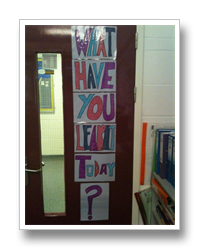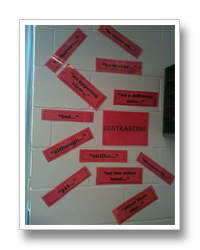At the entrance to the school reception was a bold red background upon which the schools name was proudly presented. We had arrived at Redbridge Community School.
We were met by the Headteacher, Lindy Barclay, and joined in her office by Richard Scofield for an informal welcome. Dan O’Farrell and I where given the opportunity to discuss our department ambitions and outline our aims for the visit. A series of lesson observation, tours, conversations with staff and students were concluded with an informal debrief back where we started, with the Head and Richard Scofield.
Takeaway Messages
Uniform: What a difference polo shirts and fleeces (trousers and shoes) made to the tenor of the day. Lindy very quickly showed us the subtle house colours emblems and a practical demonstration highlighted the students allegiances to their house. So, instead of uniform policing, lessons were started with ‘Good morning,’ or with students ‘sharing photos with teachers whilst they waited for the last few students to arrive. Indeed Dan felt that this was significant enough to be its own key point in his review as well.*
‘Keep it clear, keep it simple, be consistent,’ was a the message from Richard Scofield. Nowhere was this value more clearly exemplified than in the classrooms and corridors themselves. Displayed prominently in each classroom were the school learning policies and on the the whiteboard the mantra ‘B4ME ASE’ (Before me, ask someone else). On the walls, large font, simple, learning displays* (not student work) and strategically placed inspirational quotes set the tone for learning.
Every English classroom displayed that same learning keys words providing staff with useful learning tools and students with regular consistent reminders of subject specific language. In the corridors, colourful student work displays were interspersed with success boards packed with student photos that communicated this was a school proud of its students, past and present. Conversely at Hamble, its student work in the classroom, information in the corridors. A thought to reflect on. Dan added ‘nothing in rooms that wasn’t to do with learning.’ I would have to agree.
Equipment: There were no equipment issues, in the three lessons we observed, not one students asked for a pen, pencil or stationery. Simply put, school standards.
Pedagogy: A spelling league* was in operation in both the Year 8 classes we observed, challenging students to improve as individuals and as part of a team (it is a specialist sports school), adding a little competitive spice to this essential but perhaps dry task. As important, the spelling list included terms the students were being introduced to as part of their Learning Outcomes, for example eg infer or quotation. Spellings were peer marked, a tick for correct and a dot, (not a cross), for incorrect. We teachers encouraged to mark in green and not red. The devil really is in the detail.
Purposeful questioning techniques and a range of methods to solicit answers* from students were observed in all lessons. In the most inspiring lesson the teacher demonstrated a wide range of both. Most memorable, was the use of probing questions by Mrs Missouri, who probed, probed further, and further, and on two occasions further still.
Answers were gathered using a range of techniques such as hands down and ’30s think time,’ to one answer from each table and returning to the students given additional time to think. This was a key feature of the lessons, giving students time to think, to construct their answers, to correct their own answers and their peers accepted this.
The term ‘Lead Learners’* was used to outline the learning characteristics expected of the best or leading students. ‘Listening’ and ‘making effort’ were the ‘lead learner’ requirements in this given example and successful students were recognised and rewarded at the end with a house point. Simple, well executed, effective. ‘Learning eyes’ a more efficient way of saying ‘look this way and show me I have your attention, was another useful tip.
From Dan’s notes (he had discussions with staff and a meeting with Head of English, Stuart Ramsey), the additional points were made.
- Gingerbread men – using images to separate learning. In this instance a gingerbread man was drawn by the students in their exercise books with what they knew inside the lines and what they could infer/deduce outside the lines.
- ‘Redbridge Readers’ club – choose books for department (after reading openings on l’overeadingforkids’ website) and also write to celebrities to ask them for their favourite books.
- Whole school literacy focus – 4 week rotating programme – ‘sentence week’, ‘speaking and listening week’, ‘dictionary and thesaurus week’, ‘capital letter and full stop week’ – posters in every room in school
- Displays – also some English rooms had a ‘challenge wall’ with a variety of extension activities on there (eg: ‘write a description of a stereotypical teacher. Now write a description of an un-stereotypical teacher)
- Use library time (fortnightly) to go other APP grids with students
- Start of term: teacher writes letter to student, student writes letter back – fosters good relationships
- Booster activities – quick, sharp bursts - 25 mins (remember to get powerpoints from Stuart)
- Comfy reading – instead of ready at desks students can sit anywhere in class. On tables, under tables.
Summary
We concluded the day back where we started, with Lindy Barclay and Richard Scofield. After discussing our visit the focus of our conversation was mixed ability teaching. Dan’s conversation with staff outlined that they felt that it brought on the least able the most. Did it help the most able to ‘fly’? Was there a drawback? Perhaps lack of flexibility at ks4? We are certain that this will be an on-going conversation. at Hamble.
This visit was secured as a professional experience for our Head of Department, however I found it extremely valuable myself. IMHO the visit also served to establish a standards bench mark for my working relationship with Dan. Whilst our visit to Redbridge Community School has highlighted a number of pedagogical strategies, Department and school expectations, it has not provided the exact coordinates for where ‘there’ is. We need to define that destination point ourselves and we will.
After originally posting this review, Dan emailed his notes, the visit clearly had an impact on him too. Common highlights are noted with an asterix*.


